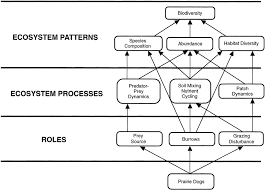Prairie dogs play an extremely significant role in the habitats in which they are found. The fact that they graze, dig holes and consume grass all contribute directly and indirectly to the degradation of grasslands. The figure below indicates their ecosystem behavior.

Keystone species significantly impact the ecosystem in which they are located. If they were to become extinct, the surrounding environment would undergo significant shifts due to impact. Traveling to different locations and communities is impossible because there are so many of them (NPS.gov (U.S. National Park Service), 2015). Examples of prairie dogs include the black-tailed prairie dog, Mexican prairie dog, Utah prairie dog, white-tailed prairie dog, and Gunnison’s prairie dog. These tiny insects create intricate passageways and tunnels deep within the earth. Even though many people view them as an annoyance, they play an extremely significant role. Because of the damage they cause to the natural world, these professionals are called “environmental engineers.” Water can enter underground tunnels through the tunnel openings or cracks that form when it rains. Drainage may improve if water is allowed to enter the water table. Therefore, there is a reduction in the amount of water lost from the surface. Because of this, there will be less surface erosion over time, which benefits the ecosystem’s health.
The Utah prairie dog, Gunnison prairie dog, white-tailed prairie dog, and Mexican prairie dog are the four most common varieties of prairie dogs (Russell Tripp & Rocke, 2019). Because they prefer to consume plants that are low to the ground, owls can forage in areas that would ordinarily support the growth of tall plants. Grazing, directly and indirectly, affects grasslands because of how animals nourish grasslands.
Reference
Russell, R. E., Tripp, D. W., & Rocke, T. E. (2019). Differential plague susceptibility in species and populations of prairie dogs. Ecology and Evolution, 9(20), 11962-11971. Web.